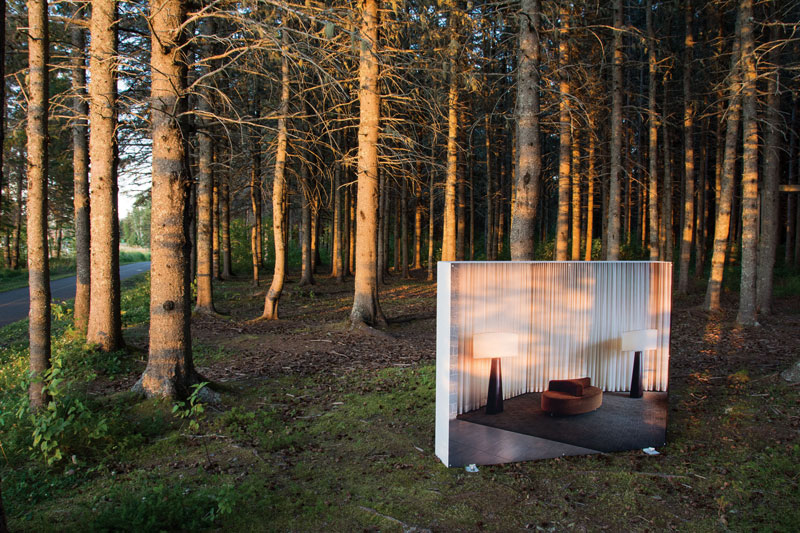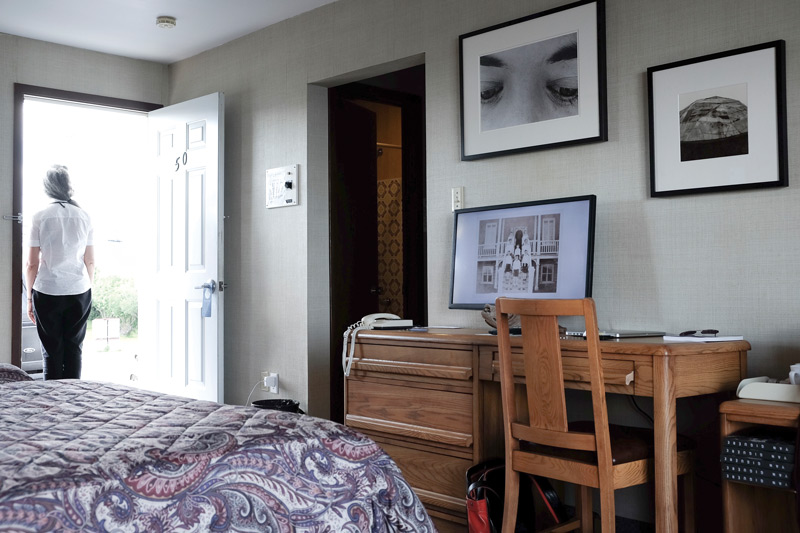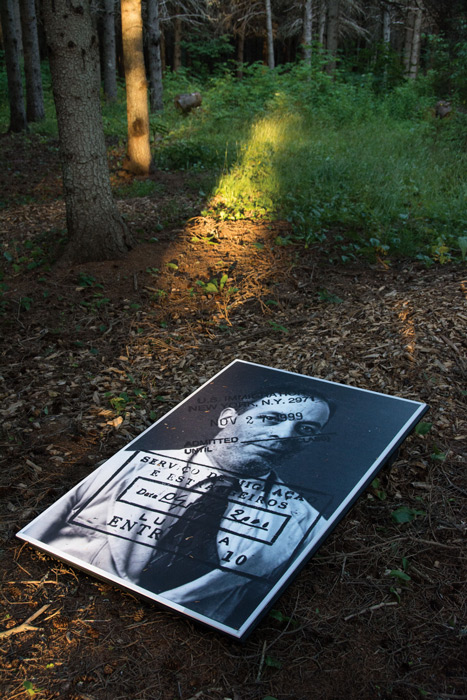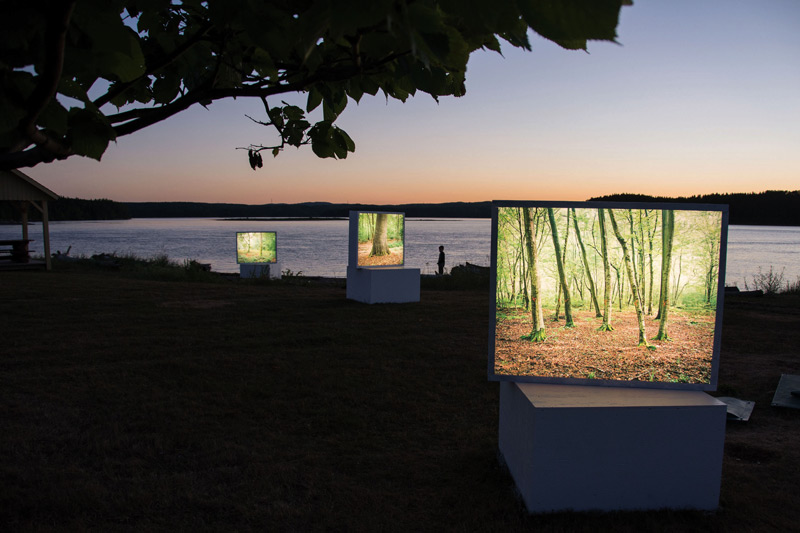[Fall 2017]
An interview by Mona Hakim
MH: What was your professional career before you founded Les rencontres internationales de la photographie en Gaspésie? Why did you decide to produce such a major photography event – and in the Gaspé, of all places?
CG: For more than twenty years I worked in the living arts, and I have always been very interested in photography and auteur cinema. I attended the Avignon festival for a number of years and was able to make side trips to Les Rencontres d’Arles during the festival and get to know different practices, authors, and professionals in the field.
When I arrived in the Gaspé, I had the wild idea of creating a new event devoted to photography and contemporary art that would be different from all the other events in Quebec and would connect the entire region and its residents. In August 2007, I contacted Jean-Daniel Berclaz, whose work I had seen at Arles in 2003, about his project Musée du point de vue. The objective was to produce a photographic action in the Gaspé by inviting five artists (including Berclaz) to a residency in 2008. In June 2009, we opened a circuit composed of ten photographic installations, set in the respective places where the landscapes had been shot, to the general public. We now call this circuit the Parcours du point de vue – Gaspésie. It was a success, and so we went ahead and made it an annual event. It was after this that the first edition of Les Rencontres internationales de la photographie en Gaspésie took place, in August 2010. This year is the eighth edition.
MH: In relation to the original objectives, what general orientations have developed and bring recognition to the event today?
CG: At the beginning, we wanted to fit within the logic of territorial development and go beyond the traditional framework of a contemporary art event. With Les Rencontres, we wanted to create a “toolbox” for artists and develop a space that would modulate through contacts with artists, professionals, and, of course, the public so that they could come together to take the noble risk of creation.
With an eye to highlighting photography and research on images – their language, codes, and various aesthetics – we have designed a circuit that is spread over more than eight hundred kilometres, in twenty-two sites and fourteen host cities, including the four national parks as of 2016. Development of publics (artist residencies, education plan) and networking (in Quebec and abroad) are now among our core activities.
MH: How are you able to bring together the public in the Gaspé and attract people from major urban centres despite the remoteness of the region? This, I presume, must be one of your main challenges, in addition to the technical logistics required by installations over a large area of the Gaspé.
CG: Our intentions were clearly stated: to reach out to and create loyalty among publics that usually do not have much to do with the visual arts. We were able to see what we had accomplished after the 2016 edition (the seventh edition), for which we had 110,426 visitors attending an average of three exhibitions. That means 331,278 exhibition visits! Art in the non-urban public space can enable us to expand cultural action extraordinarily quickly.
Of course, each edition is indeed a challenge in terms of setting up the exhibitions over such a large territory. But it immediately creates very rich, stimulating contacts among artists, contributors, and publics, who also show great inventiveness. The event evolves and takes different forms. Mediation activities are also organized throughout the year, in the context of artist residencies (between four and six), an in situ creative project, and school activities devoted to education about the image. The presence in the Gaspé of all the guest artists during La Tournée de photographes really brings people together and allows for friendly and extremely fruit ful exchanges among artists, professionals, and the public.
And by partnering with contributors, events, artist-run centres, and national and regional organizations, we address different reflections related to dissemination and the issues of contemporary creation. For example, the panel on the photobook raised, among others, the question of development of new publics and the spread of this mode of artistic expression. We are now devoting a section to photobooks every year. At the end of the exhibition, all of the books are offered to the municipal library of the Ville de Carleton in order to form a collection and develop an interest in photobooks in the region. Roundtables on the issues surrounding the discipline are also organized for each edition. All of these aspects resonate with the people, art experts and not, who come to the Gaspé year after year.
MH: Partnerships therefore seem to be a very important element in the mission of Les Rencontres. CG: Absolutely. My previous actions and my vision have turned me into a “networker”! In other words, I am firmly convinced that by working in networks with different partners, both national and international, we broaden our field of intervention. For this purpose, we have been collaborating since the beginning with artist-run centres such as Vaste et Vague and, recently, Vu in Quebec City and Agence Topo (centre for digital writing and creations for web spaces) in Montreal. We do the same thing with events such as Diaphane pôle photographique in Picardie, France (hosting, artist residencies, co-publication) and CO in Berlin (dissemination projects). We are also developing partnerships with galleries, institutions, and publishers. We created Éditions Escuminac to assist artists with their publication projects in Quebec and abroad.
MH: How do you situate yourself in relation to other players in the photography field, large and small, that have their own events? I’m thinking for example, of Mois de la photo à Montréal, now known as Momenta – Biennale de l’image.
CG: From the start, I wanted to position Les Rencontres as a reference point and an annual meeting place essential to the visual arts. It is true that in recent years, a number of photography-related events have been instituted, particularly in the regions. Other events have decided to take on much broader mandates. In my view, there are no small or large events. Each event has its place, and each event maintains or develops its mission according to its specific dissemination and creation objectives and the relations it establishes with artists and publics. If we offer high-quality visual-arts showcases and excellent conditions for artists, we will improve our impact on progress in the discipline and among the public, in both the regions and large urban centres. The danger, over the short and medium terms, is to work in isolation and to fall into the trap of requiring artist exclusivity.
MH: Each edition of Les Rencontres is conceived with a specific theme. How do you choose the themes and the artists – choices for which you alone are basically responsible?
CG: The early editions were created in synergy by Jean-François Bérubé, Catherine Arsenault, and me. Since 2015, I have been alone, and we collaborate from edition to edition with guest curators for different aspects of the event. Choosing the main theme is a relatively complex process, tied to the desire to promote writings and artists. Once the invitations to artists are made, the creative work begins in terms of maximizing visibility of the artworks and offering unique experiences to the public at each exhibition. Talks with artists and contributors, attending events here and abroad, and visits to artists’ studios and to thought-provoking spaces are all sources of inspiration. When all of these factors and influences were combined, the theme for the next edition – and even the ninth and tenth editions – was quickly sketched out.
MH: As of 2017, the event has been in existence for eight years. It is said that year seven is pivotal and a good time to take stock. What observations have you made about the path you have taken, and what are your aspirations, or challenges, for the future of Les Rencontres?
CG: Indeed, having seven editions behind us is a time for reflection and for taking stock on the good and bad moments. The eighth edition is thus a good time to put everything on the table in order to project our plans for the 10th edition in 2019 and for the longer term. First, we hope to leave this strictly event-based framework and encourage collaborations throughout the year in our territory and beyond. A number of sites have been chosen for this purpose. We will also have to enhance our exhibition spaces and our technical facilities in order to offer our artists original and optimal conditions for creation and dissemination; design mobile pavilions to make up for the lack of interior spaces for presenting original prints, videos, and other works; and create and encourage new digital -art collaborations to contribute to a better ecology for the Quebec auteur photobook, in Quebec and internationally. Finally, we have a duty for continuity and for a experimenting with new ways of doing things with the contribution of the artists, so that we are always going further.
MH: To conclude, I am tempted to ask if you feel challenged by the relatively recent trend of attaching the term “photography” to other words, notably in the titles of major events or organizations devoted to photography (more clearly in Quebec, it seems to me).
CG: Yes, we are seeing this trend now. I imagine that these events have taken this path or the title in an enlightened way, in view of specific objectives with regard to dissemination and creation. When it comes to Les Rencontres, the term “photography” is here to stay.
Mona Hakim is an art historian, critic, and independent curator. She taught art history and history of photography at the college level from 1996 to 2015. Her current research deals with issues related to contemporary photography. Most recently, she co-curated an exhibition on Quebec photography over the last fifteen years.




